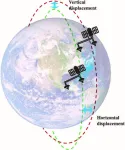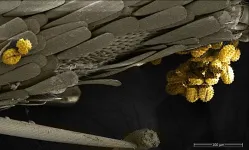(Press-News.org) Image
Artificial neural networks may soon be able to process time-dependent information, such as audio and video data, more efficiently. The first memristor with a 'relaxation time' that can be tuned is reported today in Nature Electronics, in a study led by the University of Michigan.
Memristors, electrical components that store information in their electrical resistance, could reduce AI's energy needs by about a factor of 90 compared to today's graphical processing units. Already, AI is projected to account for about half a percent of the world's total electricity consumption in 2027, and that has the potential to balloon as more companies sell and use AI tools.
"Right now, there's a lot of interest in AI, but to process bigger and more interesting data, the approach is to increase the network size. That's not very efficient," said Wei Lu, the James R. Mellor Professor of Engineering at U-M and co-corresponding author of the study with John Heron, U-M associate professor of materials science and engineering.
The problem is that GPUs operate very differently from the artificial neural networks that run the AI algorithms—the whole network and all its interactions must be sequentially loaded from the external memory, which consumes both time and energy. In contrast, memristors offer energy savings because they mimic key aspects of the way that both artificial and biological neural networks function without external memory. To an extent, the memristor network can embody the artificial neural network.
"We anticipate that our brand-new material system could improve the energy efficiency of AI chips six times over the state-of-the-art material without varying time constants," said Sieun Chae, a recent U-M Ph.D. graduate in materials science and engineering and co-first-author of the study with Sangmin Yoo, a recent U-M PhD graduate in electrical and computer engineering.
In a biological neural network, timekeeping is achieved through relaxation. Each neuron receives electrical signals and sends them on, but it isn't a guarantee that a signal will move forward. Some threshold of incoming signals must be reached before the neuron will send its own, and it has to be met in a certain amount of time. If too much time passes, the neuron is said to relax as the electrical energy seeps out of it. Having neurons with different relaxation times in our neural networks helps us understand sequences of events.
Memristors operate a little differently. Rather than the total presence or absence of a signal, what changes is how much of the electrical signal gets through. Exposure to a signal reduces the resistance of the memristor, allowing more of the next signal to pass. In memristors, relaxation means that the resistance rises again over time.
While Lu's group had explored building relaxation time into memristors in the past, it was not something that could be systematically controlled. But now, Lu and Heron's team have shown that variations on a base material can provide different relaxation times, enabling memristor networks to mimic this timekeeping mechanism.
The team built the materials on the superconductor YBCO, made of yttrium, barium, carbon and oxygen. It has no electrical resistance at temperatures below -292 Fahrenheit, but they wanted it for its crystal structure. It guided the organization of the magnesium, cobalt, nickel, copper and zinc oxides in the memristor material.
Heron calls this type of oxide, an entropy-stabilized oxide, the "kitchen sink of the atomic world"—the more elements they add, the more stable it becomes. By changing the ratios of these oxides, the team achieved time constants ranging from 159 to 278 nanoseconds, or trillionths of a second. The simple memristor network they built learned to recognize the sounds of the numbers zero to nine. Once trained, it could identify each number before the audio input was complete.
These memristors were made through an energy-intensive process because the team needed perfect crystals to precisely measure their properties, but they anticipate that a simpler process would work for mass manufacturing.
"So far, it's a vision, but I think there are pathways to making these materials scalable and affordable," Heron said. "These materials are earth-abundant, nontoxic, cheap and you can almost spray them on."
The research was funded by the National Science Foundation. It was done in partnership with researchers at the University of Oklahoma, Cornell University and Pennsylvania State University.
The device was built in the Lurie Nanofabrication Facility and studied at the Michigan Center for Materials Characterization.
Lu is also a professor of electrical and computer engineering and materials science and engineering. Chae is now an assistant professor of electrical engineering and computer science at Oregon State University.
Study: Efficient data processing using tunable entropy-stabilized oxide memristors (DOI: 10.1038/s41928-024-01169-1)
END
AI chips could get a sense of time
Timekeeping in the brain is done with neurons that relax at different rates after receiving a signal; now memristors—hardware analogues of neurons—can do that too
2024-05-20
ELSE PRESS RELEASES FROM THIS DATE:
PARC model of care associated with fewer deaths among veterans post-ICU
2024-05-20
EMBARGOED UNTIL: 10:15 a.m. PT, Monday, May 20, 2024
PARC MODEL OF CARE ASSOCIATED WITH FEWER DEATHS AMONG VETERANS POST-ICU
Session: B18 – Bridging Gaps to Improve Long-Term Outcomes
The Post-Acute Recovery Center: A Telehealth Care Model to Improve Patient-Centered Outcomes for High-Risk Survivors of Critical Illness
Date and Time: Monday, May 20, 2024, 10:15 a.m. PT
Location: San Diego Convention Center, Room 32A-B (Upper Level)
ATS 2024, San Diego – Research presented at the ATS 2024 International Conference demonstrates that veterans who received ...
Department of Energy announces $6 million for isotope R&D
2024-05-20
WASHINGTON, D.C. - Today, the U.S. Department of Energy (DOE) announced $6 million in funding for 12 awards across eight efforts to advance research in isotope enrichment, targetry, and separations. This funding is part of a key federal program that produces critical isotopes otherwise unavailable or in short supply in the U.S.
Isotopes, or variations of the same elements that have the same number of protons but different numbers of neutrons, have unique properties that make them powerful in medical diagnostic and treatment applications. They are also essential for applications in quantum information science, nuclear power, national security, and more.
“These ...
World leaders still need to wake up to AI risks, say leading experts ahead of AI Safety Summit
2024-05-20
UNDER EMBARGO UNTIL 19:00 BST / 14:00 ET MONDAY 20 MAY 2024.
World leaders still need to wake up to AI risks, say leading experts ahead of AI Safety Summit
More information, including a copy of the paper, can be found online at the Science press package at https://www.eurekalert.org/press/scipak/, or can be requested from scipak@aaas.org
Leading AI scientists are calling for stronger action on AI risks from world leaders, warning that progress has been insufficient since the first AI Safety Summit in Bletchley Park six months ago.
Then, the world’s leaders pledged to govern AI responsibly. However, as the second AI Safety Summit in Seoul ...
*FREE* Managing extreme AI risks amidst rapid technological development
2024-05-20
Although researchers have warned of the extreme risks posed by rapidly developing artificial intelligence (AI) technologies, there is a lack of consensus about how to manage them. In a Policy Forum, Yoshua Bengio and colleagues examine the risks of advancing AI technologies – from the social and economic impacts, malicious uses, and the possible loss of human control over autonomous AI systems – and recommend directions for proactive and adaptive governance to mitigate them. They call on major technology companies and public funders to invest more – at least one-third of their budgets – into assessing and ...
Advancing 3D mapping with tandem dual-antenna SAR interferometry
2024-05-20
The new Tandem Dual-Antenna Spaceborne Synthetic Aperture Radar (SAR) Interferometry (TDA-InSAR) system, addresses the limitations of current spaceborne Synthetic Aperture Radar (SAR) systems by providing a more reliable and efficient method for 3D surface mapping. The system's innovative design allows for single-pass acquisitions, significantly reducing the time required for data collection and enhancing the precision of 3D reconstructions in various terrains, including built-up areas and vegetation canopies.
Synthetic Aperture Radar (SAR) interferometry (InSAR) is a powerful tool for producing high-resolution topographic maps. However, traditional InSAR techniques face ...
Mount Sinai launches Center for Healthcare Readiness to strengthen practice and partnerships in public health emergency response
2024-05-20
The Icahn School of Medicine at Mount Sinai announced the launch of its new Center for Healthcare Readiness, bringing together a diverse team of academic and operational experts to strengthen the Mount Sinai Health System’s strategies and the U.S. health care sector’s capacity to prepare for and respond to any large-scale public health emergency.
The Center will work with both Mount Sinai’s own resources, and public and private partners at the local, regional, and federal levels, to pursue strategies in research, advocacy, innovation, and collaboration to plan ...
Study sheds light on bacteria associated with pre-term birth
2024-05-20
Researchers from North Carolina State University have found that multiple species of Gardnerella, bacteria sometimes associated with bacterial vaginosis (BV) and pre-term birth, can coexist in the same vaginal microbiome. The findings add to the emerging picture of Gardnerella’s effects on human health.
Gardnerella is a group of anaerobic bacteria that are commonly found in the vaginal microbiome. Higher levels of the bacteria are a signature of BV and associated with higher risk of pre-term birth, ...
Evolving market dynamics foster consumer inattention that can lead to risky purchases
2024-05-20
CORVALLIS, Ore. – Researchers have developed a new theory of how changing market conditions can lead large numbers of otherwise cautious consumers to buy risky products such as subprime mortgages, cryptocurrency or even cosmetic surgery procedures.
These changes can occur in categories of products that are generally low risk when they enter the market. As demand increases, more companies may enter the market and try to attract consumers with lower priced versions of the product that carry more risk. If the negative effects of that risk are not immediately noticeable, the market can evolve to keep consumers ignorant of the risks, said Michelle Barnhart, an associate professor ...
Ex-cigarette smokers who vape may be at higher risk for lung cancer
2024-05-20
EMBARGOED UNTIL: 9:15 a.m. PT, May 20, 2024
Session: B20 – Lung Screening: One Size Does Not Fit All
Association of Electronic Cigarette Use After Conventional Smoking Cessation with Lung Cancer Risk: A Nationwide Cohort Study
Date and Time: Monday, May 20, 2024, 9:15 a.m. PT
Location: San Diego Convention Center, Room 30A-B (Upper Level)
ATS 2024, San Diego – Former cigarette smokers who use e-cigarettes or vaping devices may be at higher risk for lung cancer than those who don’t ...
The impacts of climate change on food production
2024-05-20
A new peer-reviewed study from researchers at The University of Texas at Arlington; the University of Nevada, Reno; and Virginia Tech shows that climate change has led to decreased pollen production from plants and less pollen more diversity than previously thought, which could have a significant impact on food production.
“This research is crucial as it examines the long-term impacts of climate change on plant-pollinator interactions,” said Behnaz Balmaki, lead author of the study and an assistant professor of research in biology at UTA. “This study investigates how shifts in flowering times and extreme weather events affect the availability of critical food ...
LAST 30 PRESS RELEASES:
Numbers in our sights affect how we perceive space
SIMJ announces global collaborative book project in commemoration of its 75th anniversary
Air pollution exposure and birth weight
Obstructive sleep apnea risk and mental health conditions among older adults
How talking slows eye movements behind the wheel
The Ceramic Society of Japan’s Oxoate Ceramics Research Association launches new international book project
Heart-brain connection: international study reveals the role of the vagus nerve in keeping the heart young
Researchers identify Rb1 as a predictive biomarker for a new therapeutic strategy in some breast cancers
Survey reveals ethical gaps slowing AI adoption in pediatric surgery
Stimulant ADHD medications work differently than thought
AI overestimates how smart people are, according to HSE economists
HSE researchers create genome-wide map of quadruplexes
Scientists boost cell "powerhouses" to burn more calories
Automatic label checking: The missing step in making reliable medical AI
Low daily alcohol intake linked to 50% heightened mouth cancer risk in India
American Meteorological Society announces Rick Spinrad as 2026 President-Elect
Biomass-based carbon capture spotlighted in newly released global climate webinar recording
Illuminating invisible nano pollutants: advanced bioimaging tracks the full journey of emerging nanoscale contaminants in living systems
How does age affect recovery from spinal cord injury?
Novel AI tool offers prognosis for patients with head and neck cancer
Fathers’ microplastic exposure tied to their children’s metabolic problems
Research validates laboratory model for studying high-grade serous ovarian cancer
SIR 2026 delivers transformative breakthroughs in minimally invasive medicine to improve patient care
Stem Cell Reports most downloaded papers of 2025 highlight the breadth and impact of stem cell research
Oxford-led study estimates NHS spends around 3% of its primary and secondary care budget on the health impacts of heat and cold in England
A researcher’s long quest leads to a smart composite breakthrough
Urban wild bees act as “microbial sensors” of city health.
New study finds where you live affects recovery after a hip fracture
Forecasting the impact of fully automated vehicle adoption on US road traffic injuries
Alcohol-related hospitalizations from 2016 to 2022
[Press-News.org] AI chips could get a sense of timeTimekeeping in the brain is done with neurons that relax at different rates after receiving a signal; now memristors—hardware analogues of neurons—can do that too




